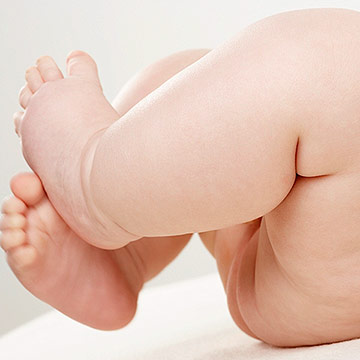
Your baby's oh-so-soft newborn skin is still developing — and that means it is susceptible to irritation. It's impossible to prevent exposure to all the things that could bother your baby's sensitive skin, but you can keep an eye out for these potential irritants.
1. Nickel
Nickel is one of the most common causes of allergic contact dermatitis — an itchy rash that appears only if someone has an actual allergy to the metal. An analysis of over 9,000 kids by the North American Contact Dermatitis Group revealed that nickel was the most common allergen in children referred for medical patch-testing. Nickel can be found in belt buckles, coins, zippers, earrings, watch straps, rings, necklaces, and, in the case of infants, snaps and fasteners for baby's clothes, like all-in-ones and kimono-style shirts. Look out for itchy red or dry patches of skin resembling a burn and rash, or bumps that align with culprit areas on clothing, or places where your jewelry or buckles may have touched your baby's skin. It may take a couple of days before the skin reacts.
Minimize Exposure: Seek out clothes that have ties instead of snaps, or no fasteners at all. If you pierce your baby's ears, make sure the studs are surgical-grade stainless steel or 14-, 18- or 24-karat yellow gold (white gold may contain nickel). Other nickel-free metals include pure sterling silver, copper, and platinum. A dermatologist may offer a topical corticosteroid cream for treatment as well, but avoidance is the best approach.
2. Neomycin
This ingredient is found in many over-the-counter or prescription antibiotic creams, ointments, lotions, eye preparations, and eardrops. In 2010, neomycin had the distinction of being named Allergen of the Year by American Contact Dermatitis Society. Look for a blistery or pink irritated patch around the site of application.
Minimize Exposure: If your little one gets a cut or scrape, clean it well with a gentle cleanser and swap the antibiotic cream for plain petroleum jelly to help healing.
3. Baby Wipes
In early 2014 there was a lot of buzz about a new study that showed that the preservative methylisothiazolinone (MI), found in some baby wipes, can lead to allergic skin reactions in some babies and children. Six children had itchy, red, oozing, or crusty patches around the bottom, mouth, and any other skin that the wipes had touched.
Minimize Exposure: Study author (and pediatric dermatologist) Mary Wu Chang, M.D., recommends minimizing exposure to preservatives by using wipes less often. At home, try to use a plain cotton washcloth and a mild cleanser. Your dermatologist can perform patch testing to test for preservative allergy. Otherwise look for brands, such as Pampers, that are MI-free.
4. Saliva and Poop
Your baby's drool and poop can be a real pain (literally) for your baby's skin (especially if it's poop combined with pee). "A baby's own stool and saliva are the biggest irritants," says Amy Paller, M.D., department chair and professor of pediatric dermatology at Northwestern University Feinberg School of Medicine in Chicago. You don't have to be allergic to get a reaction, either — anyone's skin can get inflamed from these triggers.
Minimize Exposure: You need to keep out the irritants, and that means coating the skin to keep it covered. "Parents should coat the perioral area with Vaseline or other protectants before [the baby eats or sleeps], when saliva pools," Dr. Paller says. For diaper-area irritation, frequent diaper changes and the use of zinc oxide pastes such as Desitin, Triple Paste, or Sensi-Care can help decrease irritation. If the skin is still inflamed, consider a trip to the derm for a cortisone cream.
5. Sunscreen
No dermatologist will ever recommend skipping sunscreen, but some SPF products contain organic compounds such as oxybenzone, which can cause a contact allergy on the skin of babies and children.
Minimize Exposure: For babies older than 6 months, a product with a broad spectrum SPF of 30 or higher made with naturally occurring minerals such as titanium dioxide and zinc oxide works best and is the least likely to inflame skin (or sting the eyes!). Be sure to look for sunscreen that doesn't sting baby's eyes: Baby Blue Lizard, Mustela, and Aveeno Baby Natural Protection Lotion are always good bets.
6. Detergents
Detergents can be retained in washed clothing and can be irritating. Consider avoiding fragrances and dyes in detergents, and doing a double rinse for babies with sensitive skin, especially if the rash is confined to an area under clothing. Don't forget that the parents' shirts are in frequent contact with babies and can also be an irritating factor, according to Dr. Paller. Keep an eye out for a pink, scaly rash that spares unclothed skin.
Minimize Exposure: Forget the spring scent, and stick with fragrance-free. Dreft, All Free & Clear, and Tide Free & Gentle are pretty safe choices.
7. Soaps
Suds and bubbles make bathtime fun–but they're not so great for the skin. Soaps can cause excessive dryness and inflammation, and some of the ingredients could cause skin irritation.
Minimize Exposure: Avoid products with sodium laurel sulfate and fragrances, the most common irritants. Stick with pH-neutral, nonsoap cleansers, such as CeraVe, Cetaphil, or Aquanil to decrease skin irritation and washing. Most important, don't forget to moisturize your baby's skin immediately after bathing her, while the skin is still damp, to help keep the skin soft and soothed.
Copyright © 2014 Meredith Corporation.

